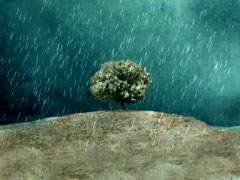|
Media Lab
Europe Human Connectedness research group WANDerful Alcove an interactive play space in which participants wield magic wands and practice wizardry Marije Kanis, Stefan Agamanolis Magic wands have a presence in the history and legends of human cultures from thousands of years ago all the way to the present day. They are simple objects that respond to human gesture, speech, emotion, and even thought, and thanks to books and movies, they are widely understood from an early age as symbols of great empowerment. As such, the magic wand presents an interesting design opportunity as a form for a tangible computer interface. In addition to exploring the technology needed to build a magic wand interface, The WANDerful Alcove focuses on role-immersion scenarios in which these interfaces can have a socially transforming effect on their users, serving as a catalyst for ad-hoc interaction and collaboration in a story experience.
The WANDerful Alcove consists of two magic wands and a large projection of a story scene consisting of a tree in an enchanted landscape. Each wand has a different magic power associated with it. Spectators who enter the alcove and pick up a wand can make something happen in the scene immediately by gesturing with a wand -- either lighting strikes or explosions depending on which wand is wielded.
Just as a real wizard student would, the participant must learn what kinds of movements to make, what kind of rhythm to use, and even what words to say in order to create the right magic. With some experimentation, the novice wizard will gain skills in the use of the wand and learn special magic gestures that cause a more controlled reaction in the story scene, either the creation of a rain storm or the emergence of the sun. Instead of competition and mutual destruction, the story concept was designed to encourage and reward ad-hoc collaboration between multiple wizards. The participant is challenged to be physically active, focusing not only on his own actions but also on that of the others, to share magic power and create something beautiful together. For example, if two wizards collaborate and perform their special gestures at the same time, a rainbow emerges from the sky.
We are exploring a variety of technologies to enable the recognition of gestures the wand user would learn as well as the kinds of gestures that people intuitively understand they should make with a magic wand. Our first prototype included tilt switches embedded in natural tree branches. The latest prototype incorporates position and orientation sensors, wireless communication, and speech recognition. We are also working on other interaction scenarios and story concepts that further explore ways to enhance a sense of immersion in a role and to encourage social contact and collaboration between people who otherwise may not have interacted with each other. Some of these scenarios could include more than two and possibly a very large number of magic wands, in which power may be shared and combined in different ways to create particular effects as in our first prototype. We wish to thank Cati Vaucelle and Glorianna Davenport of the Story Networks group for their contribution to the creation and first phase of this project. Thanks also to Brian McDonald for his assistance in developing the wireless version of the magic wand. Publications and Links
|





